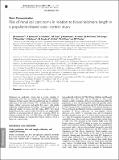| dc.contributor.author | Hofmann, J N | |
| dc.contributor.author | Baccarelli, Andrea | |
| dc.contributor.author | Schwartz, K | |
| dc.contributor.author | Davis, F G | |
| dc.contributor.author | Ruterbusch, J J | |
| dc.contributor.author | Hoxha, M | |
| dc.contributor.author | McCarthy, B J | |
| dc.contributor.author | Savage, S A | |
| dc.contributor.author | Wacholder, S | |
| dc.contributor.author | Rothman, N | |
| dc.contributor.author | Graubard, B I | |
| dc.contributor.author | Colt, J S | |
| dc.contributor.author | Chow, W-H | |
| dc.contributor.author | Purdue, M P | |
| dc.date.accessioned | 2013-04-18T13:28:03Z | |
| dc.date.issued | 2011 | |
| dc.identifier.citation | Hofmann, J N, A Baccarelli, K Schwartz, F G Davis, J J Ruterbusch, M Hoxha, B J McCarthy, et al. 2011. Risk of renal cell carcinoma in relation to blood telomere length in a population-based case–control study. British Journal of Cancer 105(11): 1772-1775. | en_US |
| dc.identifier.issn | 0007-0920 | en_US |
| dc.identifier.uri | http://nrs.harvard.edu/urn-3:HUL.InstRepos:10578872 | |
| dc.description.abstract | Background: There are few known risk factors for renal cell carcinoma (RCC). Two small hospital-based case–control studies suggested an association between short blood telomere length (TL) and increased RCC risk. Methods: We conducted a large population-based case–control study in two metropolitan regions of the United States comparing relative TL in DNA derived from peripheral blood samples from 891 RCC cases and 894 controls. Odds ratios and 95% confidence intervals were estimated using unconditional logistic regression in both unadjusted and adjusted models. Results: Median TL was 0.85 for both cases and controls (P=0.40), and no differences in RCC risk by quartiles of TL were observed. Results of analyses stratified by age, sex, race, tumour stage, and time from RCC diagnosis to blood collection were similarly null. In multivariate analyses among controls, increasing age and history of hypertension were associated with shorter TL (P<0.001 and P=0.07, respectively), and African Americans had longer TL than Caucasians (P<0.001). Conclusion: These data do not support the hypothesis that blood TL is associated with RCC. This population-based case–control study is, to our knowledge, the largest investigation to date of TL and RCC. | en_US |
| dc.language.iso | en_US | en_US |
| dc.publisher | Nature Publishing Group | en_US |
| dc.relation.isversionof | doi:10.1038/bjc.2011.444 | en_US |
| dc.relation.hasversion | http://www.ncbi.nlm.nih.gov/pmc/articles/PMC3242602/pdf/ | en_US |
| dash.license | LAA | |
| dc.subject | telomere | en_US |
| dc.subject | renal cell carcinoma | en_US |
| dc.subject | kidney cancer | en_US |
| dc.title | Risk of renal cell carcinoma in relation to blood telomere length in a population-based case–control study | en_US |
| dc.type | Journal Article | en_US |
| dc.description.version | Version of Record | en_US |
| dc.relation.journal | British Journal of Cancer | en_US |
| dash.depositing.author | Baccarelli, Andrea | |
| dc.date.available | 2013-04-18T13:28:03Z | |
| dc.identifier.doi | 10.1038/bjc.2011.444 | * |
| dash.authorsordered | false | |
| dash.contributor.affiliated | Baccarelli, Andrea | |
| dc.identifier.orcid | 0000-0002-3436-0640 | |


